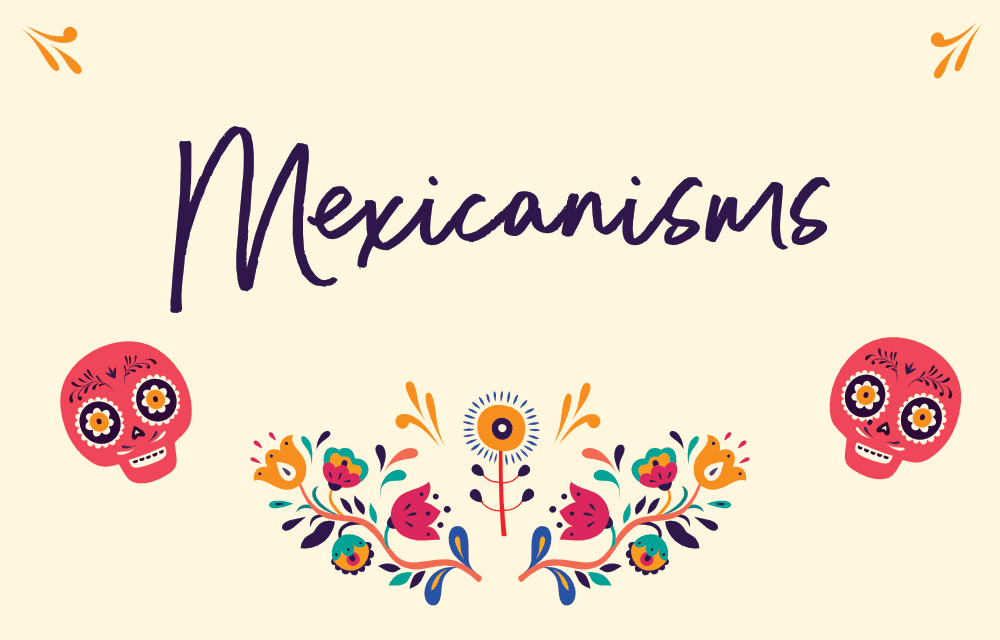If you’ve studied Spanish before, people from Mexico to Spain will likely understand you. However, the language used in Mexico is heavily influenced by indigenous languages and local customs. For that reason, some words and expressions in Spanish are pretty unique to the culture of Mexico. In this way, Mexican Spanish is not only represented by an accent or a different way to name things, but a set of Spanish varieties that feature important cultural aspects.
At TruFluency, we have prepared a comprehensive guide to help you learn Mexican Spanish, so, with a little practice, you will be able to blend right in with the locals or with your Mexican acquaintances in your country.
Mexican Spanish Grammar
In Mexico, the past tense (pretérito perfecto compuesto – for example: he viajado, he dicho) is relatively uncommon to describe finished actions. Instead, Mexicans use the pretérito perfecto simple (yo viajé, yo dije) to talk about a past action that has concluded in the present. In Central and South America, this is common as well. While the opposite, using pretérito perfecto compuesto for the same way Mexicans use préterito perfecto simple, is the rule in Spain. For example, a person that just had breakfast in Spain would say (yo) he desayunado una tortilla, while a Mexican would say (yo) desayuné una tortilla. It’s a little similar to when Americans say ‘I just ate’ and British people might say “I’ve just eaten”.
Another characteristic of Mexican Spanish grammar is the use of the second person plural ustedes to refer to a group of people – think you all, you guys, y’all, etc. However, even though it is a polite form to address others, Mexicans say ustedes regardless of the level of familiarity. In Europe, for example, Spanish speakers use the vosotros (you guys, you all, y’all, etc) when Mexicans use ustedes. This affects verb conjugation, which you can see in the next examples:
| Ustedes (Mexico) | Vosotros (Spain) |
| comen | coméis |
| duermen | dormís |
| hablan | habláis |
For example:
Tú me gustas mucho. I like you a lot.
Te quiero desde el primer día que te vi. I’ve loved you since the first day I saw you.
Mexican Spanish Syntax
A typical component of Mexican Spanish is the ellipsis of the negation in the main clause introduced by an adverbial clause. Don’t stress – we will explain!
You can see this in the following example:
Hasta que limpiemos la casa, no saldremos de la casa.
Until you clean the house, we’re not going out.
On the other hand, Mexico shares with other Latin American countries the use of the interrogative word qué in conjunction with the quantifier tan(to). For example:
¿Qué tan difícil es aprender inglés?
It’s so difficult to learn English.
¿Qué tan buen abogado eres?
What a good lawyer you are.
You may also notice a greater influence of indigenous languages among the more rural areas in Mexico, with the redundant use of clitics (lo, la, los, las). For example:
Yo lo veo feo.
Literally: I see it ugly. (It looks ugly to me.)
Additionally, in expressions of time spans, Mexicans, just like other Latin Americans, prefer the preposition por over durante, as in:
Estuvimos casados por veinte años.
We’ve been married for 20 years.
Mexican Spanish Vocabulary
So, we know there is a lot to take in! Mexican Spanish has unique aspects, just like the English in Boston has differences from the English in Texas. But don’t worry – with enough exposure, it’s relatively easy to grasp. The particular vocabulary of Mexican Spanish includes the following peculiarities:
Suffixes
Mexican Spanish uses the suffixes -ito and -ita to denote affection or respect. In this way, you can add a level of fondness to someone’s name or role in a show of warmth and appreciation. The suffixes -ito and -ita have an arguable equivalency in English to the suffix -y in ‘Mikey’ and ‘granny’. In Spanish, these examples are Miguelito (little Miguel) and abuelita (literally little grandma, but maybe it’s better translated as dear or sweet grandma). In Northern parts of the country -ito/-ita is replaced by -illo/a, as in cafecillo (little coffee).
For words ending in -n, Mexicans add the suffixes -cito, -cita to the end of the word. This does not necessarily imply small size but rather an affectionate attitude towards it. For example: camioncito (little truck) and ratoncita (little rat).
To make nouns sound larger or more powerful Mexicans use the suffix -zote, as in avionzote (huge plane). For disparaging words, Mexicans use the suffixes -uco/a or -ucho/a. Some examples are maluco (very bad) and flacucha (sickly skinny).
Other suffixes commonly used are -azo/a and -ón/a to refer to something impressive or large, respectively. For example tipazo (hot or tall guy/a really good person) and tetona (big-breasted girl).
In the State of Mexico, the negation in unmarked yes/no questions is quite common. Thus, instead of asking ¿Quieres…? (Would you like…?), people tend to ask ¿No quieres…? (Wouldn’t you like…?)

Mexicanisms
Words, phrases, and modes of expression distinctive of Mexican Spanish are known as mexicanisms. Some of them come from Spanish spoken in Spain many years ago. However, others originated in the enormous influence Mayan civilization had on the Spanish language in Mexico. Examples of commonly used mexicanisms are:
Achicopalarse
This means you feel down emotionally or unprepared to perform a task. It comes from the Náhuatl language. Example:
No te achicopales. (Don’t be sad).
Apapachar
From the same Náhuatl origins as achicopalarse, it means to massage, rub or cuddle someone. It is understood in most Latin American countries. Example:
Quiero apapacharte. (I want to cuddle with you).
Arrecholar
Common in the Mexican state of Cohauila. It stands for shutting oneself away and doing nothing. Example:
El perro está arrecholado en el rincón. (The dog is cornered).
Cantinflear
If you’re a fan of Mexican culture, you must have heard of the comedian Mario Moreno and his signature character, Cantinflas. A kind-hearted yet poorly-spoken man, Cantinflas entertained Mexicans over decades. Thus, the term cantinflear means to speak inconsistently without communicating anything useful. Besides, you can also use it to describe the action of performing something absurd. Example:
Deja de cantinflear. (Stop saying/doing nonsense).
Chambear
It’s a synonym of trabajar (to work). In this way, chamba is synonymous with the noun work. Chamba, in its part, means job position.
Chela
A regular beer. But, be wary! There is a variant, a typical Mexican beer, called michelada. This beverage differs from a standard beer in that chili powder is put on the rim of the glass. Example:
Yo solo estaba tomándome una chela con la comadre. (I was just drinking a beer with a close friend).
Chincual
It’s a classic word from the Veracruz region, meaning ‘party’. Example:
Vamos al chincual. (Let’s go to the party)
Chingaquedito(a)
Someone reserved who turns out to be two-faced, or could be bothersome to you. Example:
Es un chingaquedito, no decía nada pero hablaba mal de nosotros a nuestras espaldas. (He is two-faced, he wouldn’t say anything but he was speaking bad of us behind our backs).
Chingón(a)
You say something is chingón to convey that something is very good, positive, or pretty cool. Besides, you can also use it to describe a person. In that case, it means the person in question is very smart. Example:
Eres un chingón. (You are brilliant).
Chipocludo(a)
Someone efficient and responsible at their job. For example:
Mi hijo es el más chipocludo de su clase para las matemáticas. (My son is the most responsible at his Math class).
Escuincle
Someone bratty or childish. From the Náhuatl language, it’s synonym with ‘mocoso’ in Spanish.
No traigas a tus escuincles para el trabajo. (Don’t bring your brats to work).
Fresa
A privileged person that often brags about their social and economical status. For example:
Esa es una niña fresa. (That’s a posh/preppy girl).
Guandajón
Men who don’t look after their physical appearance and thus always wear unflattering clothes. Example:
Míralo ahí, todo guandajón. (Look at him there, all looking like a hobo).
Güero(a)
Blonde. If you want to add a dash of endearment to it, you can also say güerito/a. For example:
Mi pelo es güero, y el de ella es castaño. (My hair is blond and hers is brown).
Güey
Commonly used to address a peer or friend. However, it also means stupid or clumsy. Example:
¿Qué onda güey, cómo estás? (What’s up, man/dude? How are you?).
Locochón
It describes something daring, different, or extraordinary. Example:
Se va a poner locochón el concierto del viernes. (The concert on Friday is going to be crazy).
Merequetengue
A party or celebration, or a messy situation or obstacle in the middle of something. Example:
Se armó el merequetengue al momento de dar los resultados de las elecciones. (A whole mess started at the time of giving the results of the elections).
Neta
The absolute truth, for a Mexican. For example:
La neta, me da mucha pereza hacer ejercicio. (To say the truth, I really don’t feel like exercising).
Padrísimo(a)
While the stem might look like it has something to do with parents, it does not! Padrisimo describes something excellent or that you really like, as in:
¡El parque de atracciones está padrísimo! (The amusement park is great!)
Ruco(a)
An elderly person or to fall asleep. For example:
Me quedé ruco en el cine otra vez. (I fell asleep in the movie theater again).
Sacatón(a)
A coward, as in:
David es un sacatón por no apostar con Esteban. (David is a coward for not gambling with Esteban).
Teporocho(a)
Get drunk. For example:
Ella se quedó teporocha al pasarse de copas. (She got drunk after having way too many shots).
Teto
Nerdy or dumb person. Example:
Tu novio es un teto. (Your boyfriend is a dumb person).
Vaquetón
An unmotivated, sluggish, or insolent person. For example:
Te la pasaste allí tirado en el sofá güey viendo la tele, no me digas que no andabas de vaquetón. (You spent the time on the couch watching TV, don’t tell me you weren’t being sluggish)
Mexican Spanish Pronunciation
If you live in the United States, chances are that most of your Spanish exposure comes from hearing Hispanic immigrants speak, watching telenovelas and films, and interacting with Latino pop culture. Hence, it is likely you notice differences in the pronunciation of Mexicans when compared to other Spanish speakers from Argentina, Spain, or maybe Colombia.
The Mexican Spanish pronunciation is characterized by:
Affricates
Affricate sounds are consonant sounds that start with a complete obstruction of the breath stream and conclude with an incomplete closure that generates a sound of friction. See below for examples of affricates.
WORDS WITH TS and TL
Due to the influence of Nahuatl in Mexican Spanish, the set of affricate sounds include a voiceless alveolar affricate [t͡s] and a voiceless alveolar lateral affricate [t͡ɬ]. This leads to softer T sounds in autoctone words such as tlapalería (hardware store), coatzacoalquense (from the city of Coatzacoalcos). You can say it’s not the T in tomato, which is sharp sounding. It’s just softer.
Fricatives
Fricative sounds are consonant sounds produced by blocking the passage of the airstream, without making complete closure. As a result, the air moving through the mouth generates an audible friction.
WORDS WTIH X
Besides the usual voiceless fricatives of Latin American Spanish (such as the common F, S, and X sounds), Mexican Spanish has the palatal sibilant /ʃ/. You’ll find this sound mostly in some place names of indigenous origin, written with X. For example, Xola (shola) (a station in the Mexico City Metro) or Xochimilco (sounds like Sochimilco). While some Nahuatl and Mayan words keep their original pronunciation, others evolved over time and moved its articulation to other regions of the mouth. Thus, words like Xalapa (Halapa) or Mexico (meh-hee-ko) itself keep their velar, glottal, or uvular pronunciation.
WORDS WITH LL, Y, AND THE YEÌSMO
Yeísmo is present among all varieties of Mexican Spanish and consists of pronouncing identically letters LL and Y. Therefore, in most cases, you’ll hear a palatal fricative [ʝ] for words like Yemen or pollo (po-yo). This sound is weakened between vowels, as in gallina ( gah-(y)ee-na) and silla (see-(y)uh).
Stops
In phonetics, a stop is the momentary blocking of some part of the oral cavity.
WORDS WITH BU
The sound /bw/ often becomes /gw/ in rural speech. Hence, abuelo and bueno may be pronounced as agüelo and güeno. Other times, they’ll sound as if they were pronounced as awelo and weno.
Time to practice your Mexican Spanish!
At TruFluency, your Mexican Spanish lessons are customized to your needs. If there’s any section of this guide that you would like to focus on, we are happy to help you. Book a lesson now for as little as $35 for a trial class and become fluent sooner than you think.





